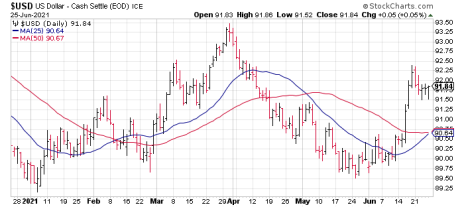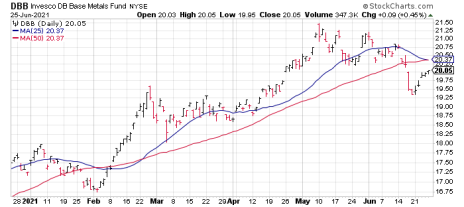The U.S. dollar and precious metals such as gold have long had an inverse relationship. And right now, that’s bad news for metals investors.
The dominant theme for precious and base metals in June has been the dollar short squeeze. This month’s sizable rally in the U.S. dollar index (USD) put heavy selling pressure on most industrial and precious metals that are priced in dollars. Gold and silver pulled back around 7% during the dollar’s rally, while copper suffered a 13% decline and platinum led the way down with an 18% drop.
At this point, however, most of the dollar short covering has likely been exhausted, and there was a pullback in USD last week. This was enough to give copper a minor relief rally, although gold and silver barely budged higher despite the dollar’s dip.
What’s Causing the Dollar Short Squeeze?
Serving as a catalyst to the dollar short squeeze event was the recent policy statement from Federal Reserve Chairman Jerome Powell, who indicated that the central bank could begin tightening interest rates by 2023, if not in 2022. While this is still a long way off, investors were spooked by the inference that prevailing easy money conditions will eventually come to a halt.
[text_ad]
It was admittedly an emotional reaction to a distant event on the market’s part, but traders may also have been discounting an earlier-than-expected Fed tightening if inflation continues to increase in the coming months.
Last week, currency analysts quoted by Reuters noted that “If the risk-off response to expected Fed tightening persists, Treasury yields and tightening views might soften temporarily, too, allowing a dollar pullback.” But what appears to be happening is that, far from going “risk-off,” market participants seem to be moving closer to embracing a “risk-on” approach once again, as evidenced by recent gains in growth-sensitive areas of the stock market.
What’s more, the 10-year Treasury Yield Index (TNX) started showing strength again late last week after recent weakness as investors seemed to be betting on a stronger economic outlook. If the 10-year yield continues rising, it will mean added competition for non-yielding bullion and give investors one less reason to favor gold as a safe haven in the near term.
Meanwhile, the leading industrial metals—particularly copper—are still in a position of short-term weakness. This can be seen in the graph of the Invesco DB Base Metals Fund (DBB), which has lately established a series of lower highs and lows and remains below its key 25-day and 50-day trend lines.
What to Do Now
While it’s always possible that the market is setting up for a classic “whipsaw” rally to confuse the metal bears, the fact remains that as long as the dollar index remains in a position of near-term strength, the safest course of action - if you invest in precious metals, like me - is to remain in a heavy cash position and avoid buying new long positions in the metals and mining stocks for now. Before you think about initiating new positions, you’ll need to see the dollar index show significant weakness by backing off levels and falling closer to its May low. Right now, the dollar’s residual strength is simply creating too many headwinds for the major metals.
Concerning gold mining stocks specifically, we also need to see substantial internal improvement before we start buying them again. As of this writing, my favorite technical indicator for the mining stocks—the 4-week momentum of the new highs and lows for the 50 most actively traded gold stocks—still hasn’t reversed its decline to let us know that the internal weakness in the gold miners has ended.
Do you have any precious metals plays in your portfolio? Tell us about them in the comments below!
*Editor’s Note: This post was excerpted from the latest issue of Sector Xpress Gold & Metals Advisor. To read more, click here.
[author_ad]



